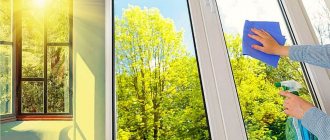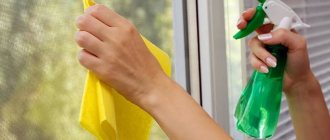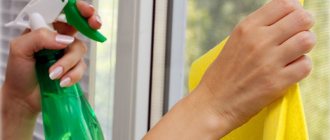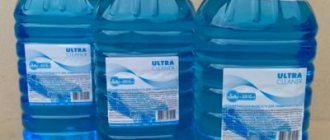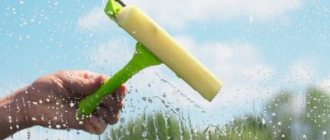How to wash windows without streaks is a question that interests all housewives. Dusty, dirty glass can ruin the impression of any room interior. Street and home dust, snow and rain leave untidy streaks and stains, which can be dealt with in several ways.
Clean windows are not so difficult to do, the main thing is to know how to do it right
Basic rules for washing windows
Rain and snow, wind with dust, condensation, tobacco smoke, traces of insects and fingerprints, children's games with paints and felt-tip pens are the main reasons for the contamination of window glass. Ideally, windows should be washed once every three months. Residents of the first floors may need more frequent cleaning, and perfectionists and pedantic cleanliness enthusiasts may repeat washing procedures even more often. Regardless of how often you wash your windows, it is better to follow a number of simple rules:
- When is the best time to wash windows? The ideal time for cleaning is cool, windless and cloudy weather. The fact is that at high temperatures the detergent will dry too quickly, and you will not have time to wipe it off without leaving streaks. The same goes for a windy day. The bright sun will cause glare, which may interfere with the quality of the washing result;
- What's the best way to clean windows? It is better to start washing windows by sorting out the deposits of things on the windowsill, if any. Then you can remove the curtains and put them in the wash. Don't forget about blinds and mosquito nets. The next stage is washing the window sill and window frames. It is better not to use soda and other abrasives for these purposes - you can damage both plastic and wood. A soap solution based on washing powder, dishwashing gel or laundry soap is ideal. To enhance the effect, you can add a few drops of ammonia. Wipe the frames thoroughly with soapy foam, and then wash off the foam with water. You can use a sponge; in the most difficult places you can use the hard part. Most of the dust and dirt from the windows can be removed using the same soapy water and a sponge, and after that, proceed to using the main detergent (store-bought or homemade). If you carefully monitor the cleanliness of your windows, you can immediately use the main product. It is better to start cleaning windows from the inside. When washing plastic windows, pay special attention to seals, drainage holes and metal fittings - you may need a brush for proper cleaning;
- what tools will be needed? Container (basin or bucket) for cleaning solution and water. You will also need a sponge, a piece of dry cloth or a microfiber cloth (the main thing is that there are no fibers left on the window from the material). Many people find it convenient to use a special glass cleaner. This is a device with a sponge on one side and a crimp on the other. The handle, as a rule, can be extended, so that all hard-to-reach places can be washed much easier. Of course, detergent is the main thing we need in the fight against stains and dirt. It is best to apply detergent to glass using a spray bottle, but you can use a sponge;
- Which product should I choose, industrial or homemade? The shelves in supermarkets and household chemical stores are literally littered with special products that promise the perfect result in the form of transparent, streak-free glass with minimal effort. Not all products are as effective as advertising promises, but many actually do their job very well. Not so long ago (many remember that time well) there were no special chemicals, so housewives used improvised means to clean glass, and it must be admitted that the windows in the apartments were no less transparent than now. Traditional recipes mean the absence of toxic and allergy-causing substances and good savings, because all the ingredients can be found at home. The result will be no worse than using store-bought products.
With ready-made products, everything is clear: you need to make a choice based on reviews or your own instinct, apply it to the glass, wash it and evaluate the result. The selection of products is huge. Folk recipes are a whole storehouse of knowledge. If you are afraid of unnecessary hassle, we hasten to please you: preparing a window cleaner at home is generally not difficult. As a rule, it is enough to mix several components, and then proceed as with a store-bought product.
Note that if a soap product or composition is used that requires rinsing, then the procedure will be as follows: apply the solution, wipe the surface with a sponge, remove all foam from top to bottom with a screed, rinse the glass with clean water, then you can go through the screed again, and now all that remains is to wipe it dry glass with a rag, paper towels or newspaper.
Where to begin
Clean glass looks sloppy if surrounded by dirty frames, there is a layer of dust in the window opening, and the window sill is covered in stains. Therefore, before washing windows, plastic or wooden structural parts are washed on both sides with soap foam. To remove old dirt, add 3 to 5 drops of ammonia. The cleaned frame is wiped first with a damp cloth, then with a dry cloth. Thoroughly wash metal fittings, drainage holes, and seals. Sometimes these places have to be cleaned with an old toothbrush or a cotton swab.
First clean the frames
Additional Information! Abrasive pastes and chlorine-containing bleaches should not be used, as these products corrode paint and form cracks in wood and plastic.
No. 1. Newsprint
This is one of the oldest and most proven methods , well known to everyone who lived through the Soviet era. Dishwashing detergent, powder or grated laundry soap must be added to warm water. Using a sponge, thoroughly wipe the frames, glass and handles, paying attention to particularly dirty areas. Now you need to rinse the glass with clean water and a clean rag and start wiping it with crumpled newspaper paper.
The secret of this method is that newsprint absorbs moisture perfectly, and this is what you need when you need to quickly get rid of water and prevent streaks. Moreover, the paper and the special composition of the ink give the glass a characteristic shine. This method was so popular and gave such excellent results that today some housewives use newsprint along with store-bought products to achieve the best results.
Note that newspapers are not the only folk remedy intended for rubbing glass until it shines. For these purposes, you can even use nylon tights , which are easily comparable in effectiveness to microfiber.
What tools will you need?
To clean windows in plastic frames, special glass cleaners with many special tools are produced. If you can’t buy them, you can use the usual set of tools:
- Water container.
- A soft, lint-free cloth that absorbs water well. It can be linen, cotton, natural suede, microfiber or spandex.
- Glass cleaner (squeeze or screed).
- A sponge, soft on one side and hard on the other.
- Gloves made of thick fabric or rubber.
- Detergents are the most important tool on which the perfect cleanliness and shine of windows depends.
No. 3. Vinegar
Using this recipe, it is fashionable to prepare a multifunctional product . Firstly, it will save you from stains, and, secondly, it will repel insects, which, let us remind you, make a significant contribution to the process of glass contamination. To prepare the solution, you need to mix a glass of warm water and 50 ml of vinegar. It is most convenient to apply the product to the glass using a spray bottle and wipe the window dry with a soft cloth or napkin.
Cleaning steps
Sliding, stained glass, fixed, dormer windows and other types of structures have to be cleaned of dirt. A common feature of the work being carried out is its clear sequence. By following a certain order, you can achieve 100% success. First of all, cleaning is carried out inside the room, and then outside.
- First come the frames. Remove dust with a dry cloth. We do not use abrasives, as they damage the primer and paintwork. Wooden frames, in addition to the above folk and store remedies, can be treated with cold tea brewing. After winter, you can find insects in them, so we use special products from animals.
- First glass cleaning. We remove the dust. At this stage, detergents are applied. Choose the appropriate direction - top to bottom or horizontal. If there are strong stains, pre-soak them with the selected product and gently wipe with the hard side of the sponge. There may be tape or glue left on the glass. We remove them with our hands, prying them up with a fingernail or a pointed object, without scratching the surface. Raw onions work well on stains left by flies. We clean the corners and joints well, as this is where dust accumulates the most.
- Second glass cleaning. This stage involves rinsing and removing product residues with dry cloths. We use cold or warm water. Generally, copious rinsing is required. With some methods it is not necessary, since it is enough to wipe the surface dry.
During the cleaning process, you can simultaneously lubricate the metal fittings with machine oil or a special product. To maintain the elasticity of the sealing rubber, we use silicone grease.
No. 5. Lemon or citric acid
Not everyone likes the vinegar smell, and if you can include yourself in this group of people, then vinegar can be replaced with citric acid, which has almost the same properties. You need to dissolve 50 ml of lemon juice in a glass of water, and then, using a spray bottle, apply the product to the glass and wipe it with a soft, dry cloth. The apartment will smell pleasantly of citruses.
There is another variation of preparation. It is necessary to fill a liter jar with lemon peel (the volume may be different, it all depends on the amount of peel collected) and fill it with a 9% vinegar solution. Let the solution infuse for 1.5-2 weeks, after which it must be filtered. The resulting liquid can be added to water and used to clean windows and floors. It will perfectly remove dirt and disinfect.
Store products
Folk remedies have a lot of advantages, but you don’t always have the time and desire to prepare them. Goods from the store come to the rescue. Both inside and outside windows are treated with liquid agents. Wooden and metal-plastic structures can be damaged by abrasives. The method of use mainly depends on the form in which the product is released. Before using any product, be sure to read the instructions from the manufacturer. The product can be applied pure or diluted. It is presented in the following categories.
- Sprays. Apply to the surface and simply wipe with a dry cloth. Very convenient for windows with bars. You can adjust the intensity and scale of spraying.
- Solutions. Diluted in water. They can be used to safely clean sliding windows without drips. The main thing is to wear protective gloves.
- Gels and pastes. Apply in pure form. Wash off with plenty of cold water.
No. 6. Ammonia
Ammonia does an excellent job of removing nicotine film , removing other contaminants and disinfecting. True, its smell is not pleasant, so after washing it is necessary to ventilate the room well. It is better to work in a protective mask so as not to damage the respiratory tract and avoid poisoning.
To prepare a cleaning solution, you need to mix 2 tbsp. spoons of ammonia and 2 glasses of water. Then everything follows the standard procedure: apply to the glass and wipe thoroughly. This solution is great for cleaning mirrors and crystal. To convince you of the effectiveness of the product, let us remind you that most store-bought window cleaning compositions are based on ammonia .
If the glass is heavily soiled, the composition can be strengthened by adding vinegar : dissolve 1 tbsp in a glass of water. a spoonful of ammonia and 1 tbsp. a spoonful of vinegar. Some recommend replacing the latter with technical or formic alcohol . The result will please you.
No. 7. Starch
Surprisingly, starch helps to cope with very dusty windows and avoid streaks. Many different folk recipes are based on it. The simplest one is to prepare a solution: 1 tbsp. spoon of starch per 1 liter of water. The mixture is applied to the glass, wiped with a sponge and left to dry. Then all that remains is to wipe with a dry cloth, getting rid of any remaining starch.
A variation of this method is to use raw potatoes . It must be cut and rubbed with a glass tuber. When the window dries, we remove the remaining starch with microfiber and enjoy the result without a hint of streaks.
What is the power of starch? The thing is that the glass is only at first glance even and smooth. In fact, it is full of dimples and scratches into which water can easily get in, dry out and leave streaks. Starch is able to weaken hydrogen bonds, preventing the appearance of streaks.
No. 11. Soda + vinegar
This famous and popular pair in households is also useful for washing windows. She does an excellent job with children's drawings on windows . In 2 liters of water you need to dissolve ¼ cup of baking soda and 100 ml of vinegar. You can take warm water so that the soda dissolves faster, since it is important that not a single crystal remains. Baking soda particles can scratch the glass. The resulting solution is applied to the contaminated surface and the effects of children's creativity are carefully wiped off with the hard side of the sponge. Then the glass is wiped dry with a paper towel.
Common Mistakes
Wrong actions can damage the glass.
The desire to quickly put the house in order often causes the appearance of drips and microcracks on the glass. To avoid mistakes, you should listen to these tips:
- Don’t rush and try to clean the stains with metal brushes or abrasive pastes. Coarse grains of cleaners and hard sponges damage surfaces.
- Before making a detergent, it is worth finding out how the ingredients combine with each other. Substances can enhance, reduce or neutralize the effects of other components. During the reaction, compounds are sometimes formed that corrode wood, plastic, and rubber seals.
- Do not pour liquids “on the eye”. When mixing the components, take into account the dosage: excess soap leaves traces that are difficult to wash off.
To ensure that there are no streaks left on the glass, the moisture is blotted with a rag or crumpled paper.
Detergents should be rinsed off thoroughly
No. 12. Onion
Experienced housewives know that onions are great for removing traces of flies . Use half an onion to rub the contaminated areas until they are completely clean. Next, all that remains is to rinse with water and wipe dry with newspaper, or use any of the methods described above and below to further clean the glass.
Procedure
By adhering to a certain order, you can clean windows efficiently and correctly without streaks:
- Wash the window frame. Remove remaining water and foam. Wipe dry.
- Pour clean water into the container and rinse the glass with a napkin. Use a scraper to drive the dirt down and remove. This will remove the top layer of contamination.
- Replace dirty water.
- Wash the surface using the selected method. First outside, then inside.
- Rinse off with clean water. Wipe with a scraper or newspaper.
- Wash the blinds and window sill.
No. 14. Glycerol
This product is not intended for washing, but to prevent contamination , or rather, to slow it down, which is also important. When the windows are perfectly washed, you want to preserve the result as long as possible, and this composition comes to the rescue, making the windows less “attractive” to dust.
The recipe is simple. You need to mix 40 ml of water and 60 ml of glycerin, add 2-3 drops of ammonia, shake the resulting mixture thoroughly and wipe the glass with it. In addition, such a mixture will provide reliable protection against icing.
How to clean windows from the outside?
If the window sashes open towards the apartment, then washing the windows from the outside can be done quite simply by using one of the means listed above. It will be more difficult if the doors are blind or swing outward. If we are talking about a private house, then a stepladder will solve the problem. To clean windows located at a decent height, you can use a telescopic windshield wiper . It has a fairly long handle that can be bent at the desired angle, reaching the most difficult to reach places. Another option is a magnetic brush , which consists of two parts: one part with the brush is attached on the outside, the second on the inside. The magnet allows you to hold the part with the brush and wash the glass in the most remote corners. Convenient, but you will need a little patience.
The windows on the first floor from the outside may be stained with dried grains of sand. Rough methods of rubbing the glass to remove dirt will not work in this case - you can only scratch the surface. It is best to apply a soap solution to the contaminated areas for 10-15 minutes so that the grains of sand soak, then it will be much easier to remove them. Then you can use any washing method.
Cleaning the window sill
This part of the window is more susceptible to contamination, so you need to devote some time to it.
If there are no specific contaminants, a soap solution , the recipe for which is given above, will cope with the task. Simply apply, rinse and remove any remaining moisture.
The product does not always work on complex contaminants; in this case, you can use industrial liquids. For example, Mr Proper, which does not harm plastic surfaces and does not require careful rinsing.
It is easier to prevent the appearance of stains on a plastic window sill:
- Do not place hot containers (pots, pans, kettles) on it.
- Place flower pots on stands or silicone mats.
- Wipe the surface daily with a dry cloth to avoid dust accumulation.
- Wipe weekly with soapy water.
Local contamination must be removed immediately. You can use a microfiber cloth or special wet wipes.
How to clean windows after renovation?
Of course, it is better to cover the windows with paper in advance to prevent them from getting dirty, but everyone has the right to make mistakes. Moreover, so many people make mistakes in this matter that many ways have been found to deal with a wide variety of contaminants formed during repairs:
- drops of chalk or lime whitewash are easily washed off with CIF gel for shiny surfaces;
- acrylic paint can be removed with gasoline or white spirit;
- cement particles can be removed from glass with phosphoric acid, but you must act very carefully so that the substance does not get on the window sill;
- the remains of masking tape are removed with drying oil, turpentine, vegetable oil or isopropyl alcohol;
- enamel and nitroenamel are dissolved with acetone;
- “Solvent 646” will help to deal with polyurethane foam that gets on the glass.
Professional products
Household chemicals require compliance with the instructions for use regarding dosage, method of application and keeping on the surface. Particular care is needed when cleaning tinted and decorative glass, as well as surfaces with solar reflective and colored coatings. It is better to test the detergent on an inconspicuous piece of glass.
Reference: the most popular cleaning products on the market are: Mister Muscle, Sanita, Clin, Cif, Help. The compositions of the listed products have been developed and tested under industrial conditions. Advantages: the effect is almost instant, the product is evenly distributed over the surface, and there are no streaks as a result.
In conclusion
We won’t mention professional products and special napkins - ubiquitous advertising will do this much better. Please note that when washing windows, do not forget about your own safety. Wear gloves, and when working with solutions with a strong odor, take care to protect your respiratory tract. Do not stand on the windowsill - use a stepladder or stable stool. It's better if someone backs you up. Do not use products based on aggressive solvents or abrasive particles. If the glass has scratches or small cracks, they can be covered with clear varnish. And remember that there are windows on sale with self-cleaning double-glazed windows, which are much less demanding to maintain than ordinary glass.
The article was written for the site.
Tags:Windows, Cleaning
We work at heights
On the first floors, wet cleaning will not be difficult. The stage of work is the same as when washing the inside. But what should those housewives who live on high floors do? The main thing is to choose the right tools and follow safety precautions.
Suitable Tools
In addition to the basic devices that were listed above, you will need special tools here. One of the main elements is a screed or mop with a long handle. They can be used to thoroughly clean a blind window from the outside. Which mop should you choose? This could be a piece of wood on which we hang a rag. A metal mop designed for cleaning floors is not suitable as it will leave streaks.
There is a wide variety of zip ties on the market, from which you can choose a model with different attachments and handle lengths. A product where the last parameter is adjustable is best suited. Sponge and fiber attachment - for removing simple dirt. If you have a rubber water goon (scraper), then we use it to remove dried stains, for example, drops of cement. After water procedures, the surfaces are wiped with a dry cloth.
Heavy contamination, including dried pieces of plaster and bird waste products, can be removed with a regular soap solution. We simply apply it before using other detergents or stick to a high concentration of soap.
Security measures
Cleaning often begins in the spring. In this case, you should wait until all the snow melts and the frosts stop. We choose strong and reliable, stable stairs, tables or chairs. When cleaning the upper floors, we do not stand on the edge of the window sill or stick our bodies out.
If you don’t have the experience of cleaning at heights or the necessary tools, then it’s better to use the help of professionals. We choose a cleaning company and order the service.
Video on the topic
Good housewives try to wash their windows on time and quickly without streaks. The right time for the first “general” of each new year is Maundy Thursday before Easter. It is interesting that our ancestors paid special attention to washing windows, believing that the clean “eyes” of a home are the key to the well-being of the family. According to signs, when processing glass, you need to put coins in the water to increase the well-being of the family.

